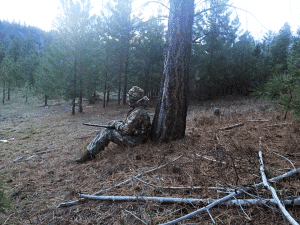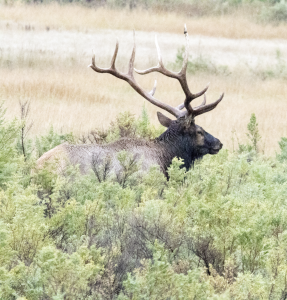
The first time I really had the opportunity to watch a flock of turkeys was in the fall when I wasn’t turkey hunting, but deer hunting. I was hunkered down and passing the time when my partner Ryan and I saw this flock come ambling by, attempting to navigate their way across dead trees and other obstacles. Watching them follow one another in a line, like ants on a log, was amusing. They would follow the bird in front of them regardless of the hazard that awaited them! One by one they would slip, fall over, or hop their way across deadfall in effort to keep pace with the others.
This year I jumped at the opportunity to try spring turkey hunting in Montana. I’d been turkey hunting once before with a hunting mentor in Nebraska but to no avail. In fact, if memory serves, that long weekend we finally gave up and went fishing instead. However, this time I was going out with a more experienced hunter, my partner’s dad, Jim. Jim and Ryan have learned over the years that while I may not enjoy early alarms, I am however highly motivated by coffee, pastries, and the prospect of game.
We traveled up a drainage where turkeys have successfully been taken for years by people I trusted, so I was hopeful but not expectant. Most mornings started by driving to various high points and overlooks to stop and call for gobblers, trying to locate an active Tom or Jake. If we heard one, the plan was to simply start walking in that direction while occasionally calling. This repeated for several mornings in a row and as someone who has come to enjoy hunting because it gets me out in the woods, all the driving made me a bit uneasy at first, but after a short while, I loved it! As a novice turkey hunter with little confidence to offer direction it was very helpful to get hear a large number of gobblers in a relatively short amount of time while seeing lots of country. It wasn’t long before I started gaining traction.
I began making the necessary connections between terrain and habitat, and the likelihood of hearing a bird. I started remembering certain landmarks where it seemed like the same gobbler was hanging out. Jim, who was unmistakably the superior turkey caller, would work the box call while I waited eagerly. Anxiously waiting to hear a turkey gobble back and sprinting off in their direction became addictive and I suspect will be my new favorite springtime activity.
One morning, a bird who didn’t sound too far away gobbled, quickly followed by another gobble. It was clear they were both heading in our direction but from either side. As I quickly set up my shotgun and aimed at where I thought the gobbler should appear, the second bird suddenly went silent. I thought if one stopped, I’ll wager the other bird bails on us too and that something spooked them or they spotted us. Finally, as the bird finally came into view, I had to stifle my laugh. He strutted and turned and puffed out his chest generating a muffled fit of laughter. Luckily, as a person at least half committed to being successful and fully committed to not angering my hunting partners I kept still. Unfortunately, he was just over the property line where we didn’t have permission and he refused to cross the fence. A close call and lots of fun, but nothing in the bag.

After hiking around the same hills I’d now traversed for several mornings, we heard a gobbler and started up a pretty steep hill. Once I settled under a tree, I spotted a Tom from way across a clearing and once again I stifled a snigger. I whisper-laughed, “Ryan! There’s a turkey…and he’s running straight at us. No seriously! There’s another one. And some hens! Get ready.” While I got ready and the Tom trod closer, I never had more than a brief headshot, far too brief to feel comfortable. Quickly, he moved into Ryan’s viewshed and a shot went off.
When we returned to the truck, Jim was beaming with excitement expecting to see a long-beard slung over one of our shoulders but we came bearing only the tale. Now, this story isn’t about Ryan’s near-miss that day but my overall experience. Nor is it a reflection on my hunting guides’ abilities. To be fair, you can only lead a horse to water. I learned many lessons this spring, solidifying that it’s always good to get outside because you never know what you’ll find. I’d rather be in the woods in the early morning and miss than never experience turkey hunting at all.
Although I was fruitless in bringing home the turkey bacon, I did find gratification in the woods. I heard Sandhill cranes, annoyed some squirrels who returned the favor, startled elk, and most importantly, called a gobbler to within range. However, Jim was still grinning. He’d found a dirty crumpled old $20 bill while picking up cans. He looked at us, laughed, and declared “Who says recycling doesn’t pay?”
by Naomi Alhadeff.





